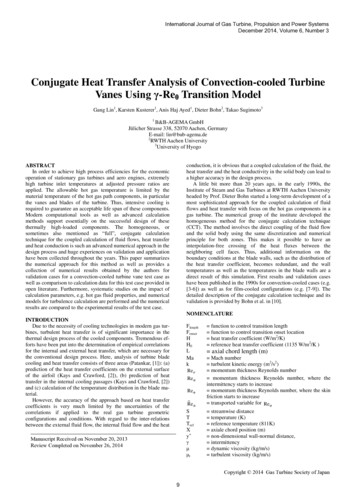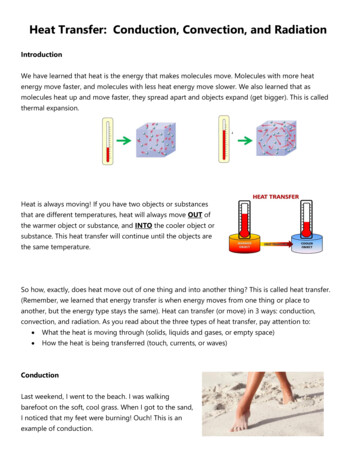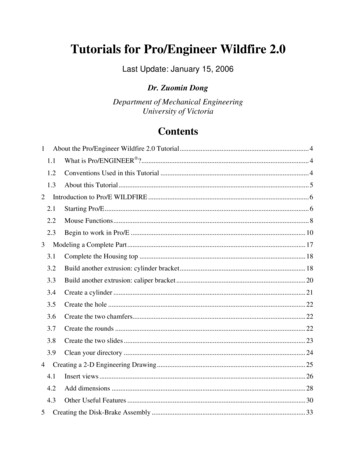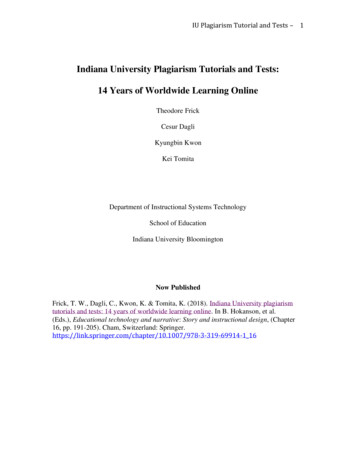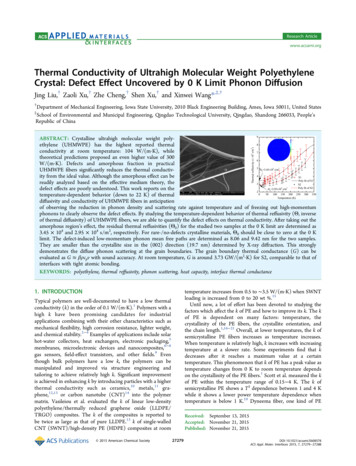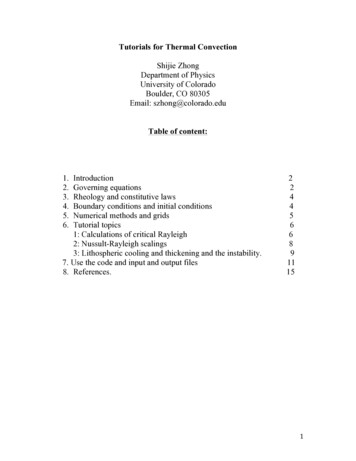
Transcription
Tutorials for Thermal ConvectionShijie ZhongDepartment of PhysicsUniversity of ColoradoBoulder, CO 80305Email: szhong@colorado.eduTable of content:1.2.3.4.5.6.IntroductionGoverning equationsRheology and constitutive lawsBoundary conditions and initial conditionsNumerical methods and gridsTutorial topics1: Calculations of critical Rayleigh2: Nussult-Rayleigh scalings3: Lithospheric cooling and thickening and the instability.7. Use the code and input and output files8. References.22445668911151
1. IntroductionThermal convection in planetary mantle is an important physical process thatcontrols thermal evolution of terrestrial planets. Terrestrial planets containradioactive heating in the mantle and primordial heating (i.e., resultedlargely from the core formation). Thermal convection occurs in the mantle torelease the heating and cool the planets. Tectonics and volcanisms aresurface manifestations of this convective process.Mantle convection may take different forms for different planets. On Earth,mantle convection involves recycling of the surface or oceanic lithosphereand results in plate tectonics. Because the lithosphere is relatively cold,recycling the lithosphere represents an extremely efficient way to release theheat and cool the mantle. On Venus and Mars, mantle convection appears tooccur below a thick stagnant lid with rather different characteristics.Mantle convection is a highly non-linear process with non-linear rheologyand energy transfer. For this tutorial, we study basic characteristics ofthermal convection by using a computer program called citcom (Moresi etal., 1996). Citcom solves the conservation equations of the mass, energy,and momentum for thermal convection problems by using a finite elementmethod. For this system of equations, there are two controllingnondimensional parameters: Rayleign number Ra and internal heating rate H(Ra is a measure of convective vigor). For a given Ra and H, citcom can beused to find heat flux at the surface and bottom boundary, flow velocity,temperature, and other important physical parameters.2. Governing equationsThe governing equations for thermal convection are the conservationequations of the mass, momentum, and energy. Over large time scales( 10,000 years), the mantle may be approximated as incompressible fluid,and then the mass conservation becomes continuity equation. The largemantle viscosity or Prandtl number (viscosity divided by thermal diffusivity)enables us to ignore the inertial terms in the momentum equation. To thefirst order, we can also ignore viscous heating and adiabatic heating in theenergy equation. The governing equations can be written as ! 0,(1)2
! ! ! ! !!!!!!!! !"!! 0, u ! ! ! ! !",(2)(3)where u, P, η, ρ, and T are the velocity, pressure, viscosity, density, andtemperature, respectively; ez is the unit vector in vertical direction; cp, k, Hand t are the specific heat, thermal conductivity, internal heating productionrate and time, respectively. ρ can be related to coefficient of thermalexpansion a and reference surface density and temperature as! !! [1 ! ! !! ].(4)In fluid dynamics, we often like to deal with dimensionless numbers. Forexample, we normalize depth of mantle by the thickness of mantle, whichyields dimensionless thickness of 1. The real advantage of this practice is toidentify controlling parameters that result from nondimensionalize thegoverning equations. For example, for thermal convection problems, twoimportant nondimensional parameters can be immediately identified,Rayleigh number, Ra, and internal heating parameter, H. Then for thermalconvection problems, whether they are for the upper mantle convection, orwhole mantle convection, or convection for Mars, as long as Ra and H arechosen to be the same, the dynamics as dictated by the nondimensionalequations is the same.Equations (1)-(3) are nondimensionalized using the following characteristicscales: length D; time D2/κ, viscosity η0, temperature ΔT, where D, κ, η0and ΔT are the thickness of the box, thermal diffusivity, reference viscosity,and temperature difference across the box depth. The non-dimensionalequations are ! 0,(5) ! ! ! ! !!"!" ! ! ! ! !, !"#!! 0,(6)(7)where dimensionless parameters Ra, Rayleigh number, and Q, internalheating rate, are3
!" ! !! !!"!" !!! !!!!!! ! !,,(8)(9)For this tutorial, we will assume Q to be zero, and such convection is oftenbasal heating convection. This leaves only one controlling parameter: Ra.3. Rheology and Constitutive LawsThe mantle rheology describes how rocks deform or flow under mantle Tand P conditions. Two common ways to study the rheology are 1) toexamine how rocks deform in the laboratory under conditions as realistic asone can achieve and 2) to model Earth's response to certain forces (e.g.,post- glacial rebound). It is generally agreed that mantle rocks are muchweaker and easier to deform under higher T. However, mantle viscosityincreases with P. In some part of the mantle, deformation is accommodatedvia diffusion creep, while dislocation creep is the dominant deformationmechanism in other part of the mantle. For dislocation creep deformation,mantle viscosity also depends on stress and is controlled by what is oftencalled power-law rheology.For this tutorial, we will use the simplest form of rheology: constantviscosity throughout the box, η0.4. Boundary Conditions and Initial Conditions.For any differential equations, we need to specify boundary conditions tohave a unique solution. For time-dependent problems, we also need initialsolutions. For our 2-D Cartisian models of this tutorial, we use free slipboundary conditions (i.e., zero normal velocity and zero shear stress) for thefour sides of the box and isothermal boundary condition for the top andbottom boundaries (i.e., T 0 and 1 at the top and bottom respectively) andreflecting (or zero heat flux) boundary condition for the two sidewalls.However, other types of boundary conditions are often used as well, such asprescribed surface velocity or bottom heat flux.Initial temperature is needed as an initial condition for the time-dependentenergy equation (unlike wave equations which require both initial4
displacement and velocity to specify the solution because of their 2nd orderderivatives with time, our energy equation only has first order derivativewith time and requires only one initial condition). In thermal convectionstudies, often we are interested in steady state solutions by running modelsfor many time steps. Quite often, these steady state solutions (or statisticallysteady state) are rather insensitive to initial conditions.For critical Ra and Nu-Ra calculations in this tutorial, the initial temperatureis given as!"! !, ! ! !cos ( ! )sin (!"),(10)where p is the magnitude of the perturbation (e.g., several percent), and L isthe nondimensional length of the box. For the tutorial problem oflithospheric cooling and subsequent instability, the initial condition is! !, ! 1 ![rand() 0.5],(11)where rand() stands for a random number in the range of 0 and 1.5. Numerical Methods and GridCitcom employs a multigrid finite element method that solves for velocityand pressure via a primitive variable formulations [e.g., Hughes, 1987]. Ituses the stream-line upwind Petrov-Galekin (SUPG) for energy equation[e.g., Brooks, 1980]. Some of the implementation issues are discussed inMoresi and Solomatov [1995]. This version of code also includes someenhancements (full multigrid and consistent projection) that are discussed inZhong et al. [2000]. Most of you as a user may not care that much aboutthese issues, but if you do, you can always check up these references.5
6. Tutorial topics6.1. Calculations of critical Ra.As we have learned, for a fluid layer with differential temperature ΔT acrossthe layer, when Rayleigh number is above a certain value, Ra c, the fluidlayer is unstable against perturbation and thermal convection will take place.Ra c is the critical Rayleigh number. When Rayleigh number of the fluidlayer is smaller than Ra c, the layer is stable and thermal convection cannotoccur. As shown in Turcotte and Schubert (2002), when initial temperaturetakes the form of equation (10) and the fluid layer has free-slip andisothermal boundary conditions, Ra c depends on the wavelength of theperturbations (i.e., L in equation (10)), and is given byRa c (π 2 k 2 ) 3,k2(12)6
where k 2π/λ is the wavenumber, and λ is the nondimensional wavelength.For reflecting boundary conditions used here, λ 2L or k π/L, where L is thenondimensional length of the box. Clearly, for a unit aspect of box with L 1,Ra c 8π4 779.27.For this part of the tutorial, we determine Ra c using Citcom code andcompare results with that from (12). We will follow the following strategy.As we know, for Ra Ra c, the initial perturbation given by (10) will decayaway or horizontal gradient given in (11) will decrease with time. However,for Ra Ra c, the opposite will happen. A good measure is the kinetic energyof the flow for the box, KE,!! 1/2! !!"!# .(13)KE increases/decreases as the perturbation increases/decreases. Therefore,for a given Ra in a calculation, by monitoring KE with time, we candetermine whether Ra is smaller or larger than Ra c. We can run multiplecalculations with different Ra to bracket or determine Ra c.Knowing Ra c 779.27 for a unit aspect box (i.e., L 1), you should first tryto determine Ra c using Citcom. Use input file input Racr and try two caseswith Ra 800 and Ra 760, respectively, to see how KE varies with time foreach case. In the output directory (e.g., CASE1), you will see a filea.time dependence and the first and second columns of this file are time andKE, respectively. You should try more cases to further narrow downnumerically determined Ra c to see how well you can determine Ra c.Here are some further questions to try or think about.A) Vary box length L to see how well you can reproduce results from(12).B) Does the magnitude of the perturbation p in (10) affect your results ofRa c?C) Equation (12) is obtained from the linear stability analysis thatsuggests that the velocities and perturbations grow exponentially withtime for the initial stage. Can you check KE from the output file to seehow it varies with time?D) If the initial perturbation in equation (10) is modified as!"! !, ! ! !cos ( ! )sin (2!"), i.e., the z dependence is changed,do you think that Ra c would change?7
6.2. Nu-Ra scalings.For entirely basal heating thermal convection with free-slip and isothermalboundary conditions, we have learned that as Ra increases, heat flux orNussult number Nu will also increase in a scaling form: Nu aRa1/3. We alsoknow that thermal boundary layer thickness δ should also scale as δ Ra-1/3and flow velocity u Ra2/3.Here we will compute multiple cases with different Ra in a unit aspect boxand quantify outputs of heat flux Nu, flow velocity u and thermal boundarylayer thickness δ to see how well they follow the above scaling laws.Different from the first tutorial calculation that only needs the initial stageresults, here calculations need to be computed to approximately steady state(i.e., until heat flux does not change appreciably with time) and dependingon Ra, you may need to run the calculations for thousands of time steps. Forpractical reasons, do not use too high Ra (why?), and try Ra 104, 3x104, 105,3x105, 106, and 3x106.Use input file input Nu Ra to do calculations with different Ra. To checkthe time dependent heat flux and characteristic flow velocity, go to the filea.time dependence, the 3rd, 4th, 5th and 6th columns are for surface heat flux(Nu), bottom heat flux, surface averaged velocity and bottom averagedvelocity, respectively (the first column is the time). Check to see whetherthey are in the steady state. Only use the steady state results of surface Nuand velocities for fitting scaling laws for different Ra. You may need to usesoftware package grace or matlab to fit the scaling laws for a set of Nu-Ravalues or u-Ra values.You should also use GMT script plot temperature velo to plot temperatureand flow velocities and also surface and bottom heat fluxes at different timesteps. Pay attention to flow and temperature patterns (e.g., hot upwellings)and also how surface and bottom heat flux patterns are related to the interiortemperature and flow patterns. You will need to modifyplot temperature velo to suit your need.Here are some further questions to try or think about.A) How would you define thermal boundary layer and determine itsthickness δ? Hint that there are output files a.ave z.timesteps for8
horizontally averaged temperature (the second column) versus depth z(the first column).B) If you can determine δ, can you try to fit the scaling δ Ra to seewhether it is what you expect?C) What do you need to do for your numerical grids when Ra is large?Why?6.3. Cooling and thickening of lithosphere and subsequent instability.For a box with insulating sidewalls and uniform temperature T 1everywhere except for the surface where T 0 is subscribed as boundaryconditions (the bottom boundary is kept at T 1), the box will cool from theabove, and a top thermal boundary layer will develop and thicken with time.As long as heat conduction is the dominant mode of heat transfer and thethermal boundary layer is much thinner than the thickness of the box, thetime evolution of the temperature field T(z,t) is governed by the well-knowncooling half-space model (e.g., Turcotte and Schubert, 2002). However, thetop thermal boundary layer is gravitationally unstable. One can understandthe process as following. When the top boundary layer thickness δ reaches acertain value, such that Raδ ρgαΔTδ3/(ηκ) reaches a critical value Ra cd,then the thermal boundary layer becomes unstable, and the boundary layerdestabilizes and drives convection.We may derive the time it takes for the instability to occur, or the onset
and t are the specific heat, thermal conductivity, internal heating production rate and time, respectively. ρ can be related to coefficient of thermal expansion a and reference surface density and temperature as ! !![1 !! !!]. (4) In fluid dynamics, we often like to deal with dimensionless numbers. For example, we normalize depth of mantle by the thickness of mantle, which yields .


